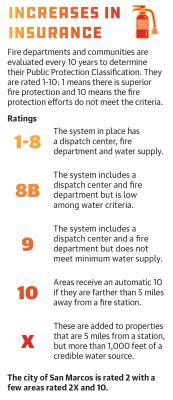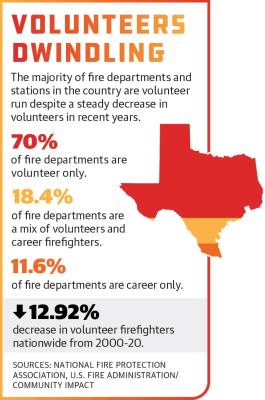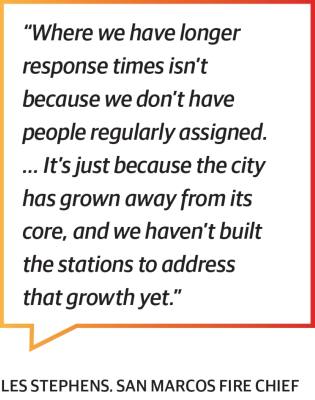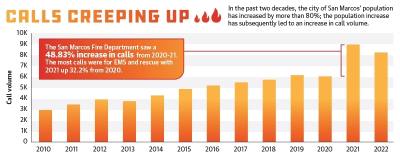Station 13 was the last volunteer-run fire station in the county, and in December, the Hays County Emergency Services District No. 3 opted to allocate $1.39 million of sales tax funds to hire almost two dozen firefighters and make the pivot from volunteers.
“We were the last full volunteer department in the county, and we identified, a couple of years ago, that the staffing model needed to change,” SHFD Chief Robert Simonson said. “We looked at the sales tax revenue, and we decided that the time was right because of the staffing, and we were a little bit more financially stable, to move towards career staffing.”
Prior to the board action allocating funds for staffing, Simonson was looking at data to figure out how to make that move a possibility.
“As brick-and-mortar stores were forced to close and people became more comfortable shopping online, it changed our purchase power,” Simonson said. “Sales tax is generated where the cash register is. Now, you’re ordering from your living room; you’re checking out at your living room.”
E-commerce, or online sales, steadily increased by 185.47% nationwide from 2018 to 2021 with an increase between 2019 and 2020 at 43.88%, according to data from the U.S. Census Bureau.
The increase in sales tax in the county during the COVID-19 pandemic and subsequent lockdowns left a larger pool of funds to pull from for staffing.
Volunteers dwindling
The number of volunteer firefighters has historically made up the majority of overall firefighters in the country. In 2020, there were around 364,300 career firefighters, or around 35% overall, with 679,900 volunteer firefighters, or around 65%, according to data from the National Fire Protection Association.
Those numbers have fluctuated in the past several decades. From 2003-20, the number of volunteer firefighters decreased by 123,000; the number of career firefighters increased by around 67,000.
However, the number of firefighters overall has remained steady with a range of 1.08 million to 1.16 million, which has struggled to keep up with the growth and demand in areas like Hays County.
Since the allocation of funds in December, the South Hays Fire Department has had some luck in recruiting more staff with several part-time hires, Simonson said; one former volunteer returned as a part-time firefighter.
Tyler Kunz has been on and off volunteering for various stations throughout Texas since his high school days in northwest Harris County.
Kunz’s first time volunteering for the SHFD was in 2006; a lot has changed since then, he said.
“There’s been a lot of growth both in the city and out in the county, and I can see where it’s taking a toll on the development of the city’s infrastructure and the city’s emergency services versus our city services out in the county,” Kunz said.
Getting ahead
The staffing struggle has been a nationwide issue, San Marcos fire Chief Les Stephens said, and San Marcos is no exception.
“Due to the growth, especially in Texas, there’s a lot more demand,” Stephens said. “When I came to San Marcos in 2009, we had a staff of about 54 firefighters total. Today, we’re at 101.”
While the San Marcos Fire Department has seen a “significant increase” in staffing over the years, it is still understaffed by around 24 people, Stephens added.
“The pipeline, unfortunately, just hasn’t increased proportionately to supply [to] meet that need,” Stephens said.
In 2010, when the city of San Marcos’ population was around 44,000, based on U.S. Census Bureau data, the department received a total of 2,930 calls. By 2021, with a population of around 68,500, the calls tripled to 8,931.
Additionally, from 2020 to 2021 alone, there was a 48.84% increase.
“Where we have longer response times isn’t because we don’t have people regularly assigned. ... It’s just because the city has grown away from its core, and we haven’t built the stations to address that growth yet,” Stephens said.
The average response time in 2022 was just under eight and a half minutes, Stephens said.
“The time the dispatcher answers the phone ... until the fire apparatus pulls up in front of your house is roughly eight minutes, and that’s not bad. It could be a little better, but it’s not bad for a total overall response time,” Stephens said.
He added there are plans to expand the fire station network in the city, and some are close to fruition, but there is not funding secured for all of them.
There are at least four potential fire stations in the works throughout the city to accommodate the growth and future developments. Three of the four future stations are targeted to the outskirts of San Marcos with one set to be centrally located on East MLK Drive.
Additional stations farther from the city’s core will not only help with response times, but also homeowners insurance rates tied to those times.
The Insurance Services Office is one of the companies responsible for evaluating all the fire stations in the nation based on a station’s water supply, dispatch, calls, staffing and station locations, among other criteria. The Public Protection Classification program has a ranked scale from 1-10, 1 meaning there is superior property fire protection and 10 meaning the community’s fire protection does not meet the minimum criteria, according to the Texas Department of Insurance.
Areas that are more than 5 miles away from a fire station automatically receive a 10.
ISO aims to evaluate stations every 10 years, Stephens said, to assess the area’s growth and ensure the departments are providing adequate resources to the city.
San Marcos was last evaluated in 2015 and earned a rating of 2 in most areas of the city. Some areas are rated 2X, meaning the properties are located farther than 1,000 feet from a fire hydrant. Some areas are rated a 10 as they are too far from a fire station.
“You would see a pretty significant, probably a 4-7%, increase in your homeowners rate because of the location of your home and the lack of adequate fire protection,” Stephens said.
Ultimately, additional stations and staffing will aim to decrease response times and help keep the city’s rating reasonable.











